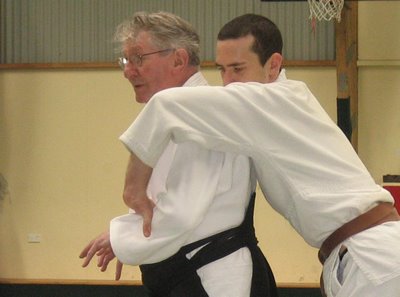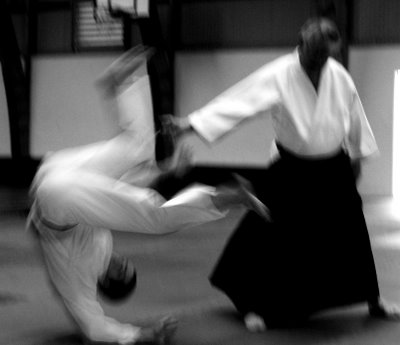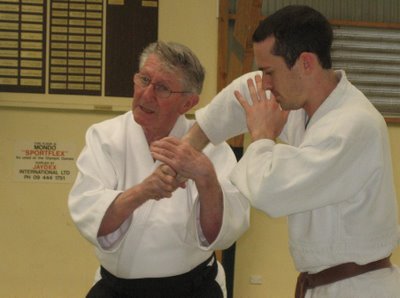


During the Easter break,
Kyu Shin Do Aikido were proud to host a seminar by the Worldwide Technical Director of
The Institute of Aikido, Sensei H. W. Foster, 7th dan.
Sensei Foster brought with him a small entourage which included Sensei Simon Thackeray, 5th dan, Sensei Trish Matthews 3rd dan and Sensei Paul Foster-Dent, 3rd dan as well as three kyu graded students included James White (from Sensei Foster’s Hut dojo) who acted as uke for the majority of the weekend.
First point that needs mentioning is that the floor of the venue, Northcross intermediate school is very, very hard. By no means is this a typical sprung wooden gymnasium floor, more of a cold, hard slab of concrete, covered with a minute layer of rubber.
With only basic jigsaw mats the weekend proved to be “challenging”, based upon Sensei Foster’s previous seminars, which do tend to err toward the ‘vigorous”.
From the outset, it was clear to all that the theme for the seminar was to be kihon or “basic” technique. On the opening day, study was focussed on techniques from a basic shomen attack and pretty much all the major pins and throws were covered, with a few kokyu variations thrown in for good measure! For the non-practioners out there reading this, basically the main man wanted to make sure everyone was singing from the same hymn-book!
The attendance for the Friday was over 50 I believe (in fact, attendance over all four days was impresive considering how highly Kiwi’s value the Easter break as a last chance to get some decent fishing done before Winter…), and everyone present coped very well, with a special mention to the handful of juniors who lasted the full day and seemed to thrive on training with the senior grades.
The afternoons were spent partly on tai-jutsu and partly on Aiki-ken and Aiki-Jo, and it was very interesting to see the different approaches to the weapons system taken by the various styles of Aiki represented on the mat. Sensei Foster as always emphasised the importance of the relation between “weapons” practice and body technique, and his demonstrations clearly showed his deep insight into this aspect of the art.
Sensi Foster’s belief is that many Aikido techniques were taken from Sword school movements, but that
Aiki-ken and
Aiki-Jo were developed based upon movements in
Aiki tai-jutsu (body technique). The more I look at this theory, and the more I pick up about iaido and the like, the more I’m sure he’s right – The weapons system Saito sensei put in place clearly bears little resemblance to traditional sword schools, but completely re-inforces all the fundamentals of Aikido body movement.
For those of you reading this who “don’t like weapons practice” I say think of it this way; by learning the suburi, awase and kata in
Aiki-ken and
Aiki-jo, you are imprinting a set of correct habits with regards to your posture, movement and mai-ai (distance). This will stay with you forever, and I know from personal experience that whenever I get a
problem with a particular technique, 99% of the time I can look at how it relates to the weapons system, and Lo! there is the answer.
Think of our weapons system as a mental reference book – everything we do in aiki is in there somewhere if you look deep enough.
The system is not called “Riai”, or the Blending of Truths for nothing.
O-Sensei created a trinity of Tai-jutsu (the empty-handed techniques of Aikido), Aiki-ken (sword) and Aiki-jo (staff). The sword (in practice, the Bokken or wooden sword) and Jo (staff) are both traditional weapons in Japanese Budo. But O-Sensei developed the use of these two weapons into something very much his own. The body movements, hip movements, hand movements and evasive positioning are all connected to each other, whether using one of these weapons or not.
Practicing Aiki-ken and Aiki-jo is not only a very interesting and fascinating type of training in itself, but it enhances every aspect of the body techniques as well. Learning these universally applicable principles enables the Aikido practitioner to handle attacks from multiple opponents, as well. This is due to the principle of moving off the line of attack in the initial defensive movement; something that is very easily understood when practicing against an attacker with a sword or staff!
At a more advanced level, the practice of, for example, the kumi-tachi, one can start to see how important it is to “control the centre line” when facing an opponent who is moving through different angles to attack you. This is a core principle not only of Aikido, but of self-defence.
Thanks for taking the time to read this blog, and I hope it makes you want to find out more about Aikido
www.aikido4beginners.co.uk







